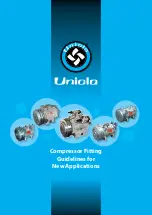
6
Draining the Tank
WARNING
Air tanks are under high pressure.
Keep face and other body parts
To help prevent tank corrosion and keep moisture
out of the air used, the air tank of the compressor
should be drained daily.
To drain:
Checking the Release Valve
DANGER
The release valve should be checked before each
day of use by pulling the ring by hand.
pack.
2. Pull the ring on the release valve to release air
until tank pressure gauge reads less than 20 psi.
3. Release the ring.
4. Turn the drain valve 90° counterclockwise to the
ON
(open) position.
5. Tilt tank to drain moisture from tank into a suitable
container.
NOTE:
Condensate is a polluting mate-
rial and should be disposed of in compliance with
local regulations.
6. If a drain valve is clogged, release all air pressure,
remove and clean valve, then reinstall.
7. When storing, leave drain valve open to allow
moisture to completely drain out and help prevent
corrosion on the inside of tank.
8. Turn the drain valve 90° clockwise to the
OFF
(closed) position.
MAINTENANCE
WARNING
1. Install the battery pack.
2.
3. Turn the air compressor
OFF
(O).
4.
5.
WARNING
To reduce the risk of personal in-
WARNING
Use only recommended accesso-
ries. Others may be hazardous.
Maintaining Tool
jury and damage, never immerse
your tool, battery or charger in liquid or allow a
Cleaning
Storage
Always turn OFF the air compressor, remove the
battery pack, release all pressure, disconnect air
hose and air tools, allow unit to cool to the touch,
and drain the tank
before storing. Leave drain valve
open to allow moisture to completely drain out and
help prevent corrosion on the inside of tank.
Repairs
For repairs, return the tool, battery and charger to
the nearest authorised service centre.
ACCESSORIES
away from outlet when relieving pressure.
Always wear proper eye protection marked to
comply with AS/NZS 1337.1.
Do not tamper with the release
valve. The release valve will
automatically release air if the air tank pressure
exceeds the cut-out pressure. The release valve
must work properly when operating the air
compressor. If the release valve is stuck open,
or does not open when the ring is pulled, do not
use the product and contact a
MILWAUKEE
®
service facility for repairs.
If air continues to escape once the release valve
is closed, contact a
MILWAUKEE
®
service
facility for repairs.
Pull the ring on the release valve to release air
pressure for three to five seconds. Release the
ring. The release valve must reset and hold
pressure before all compressed air is exhausted
from the tank/pressure vessel.
Turn the air compressor to
AUTO ON
(I) and
allow the tank to fill. The compressor will shut off
when the pressure reaches the cut-out pressure.
To reduce the risk of injury,
always unplug the charger and
remove the battery from the charger or tool
before performing any maintenance. Never
disassemble the tool, battery or charger.
Contact a
MILWAUKEE
®
service facility for ALL
repairs.
Always turn OFF (O) the air compressor, remove
the battery pack, release all pressure,
disconnect air hose and air tools, allow unit to
cool to the touch, and drain the tank before
cleaning or making repairs on the air
compressor.
Keep your tool, battery and charger in good repair
by adopting a regular maintenance program.
Inspect your tool for issues such as undue noise,
misalignment or binding of moving parts, breakage
of parts, or any other condition that may affect the
tool operation. Return the tool, battery, and charger
to a
MILWAUKEE
®
service facility for repair. After
six months to one year, depending on use, return
the tool, battery and charger to a
MILWAUKEE
®
service facility for inspection.
If the tool does not start or operate at full power with
a fully charged battery, clean the contacts on the
battery. If the tool still does not work properly, return
the tool, charger and battery, to a
MILWAUKEE
®
service facility for repairs.
For a complete listing of accessories, go online to
www.milwaukeetool.com.au/
www.milwaukeetool.co.nz or contact a distributor.
Clean dust and debris from vents. Keep handles
clean, dry and free of oil or grease. Use only mild
soap and a damp cloth to clean, since certain
cleaning agents and solvents are harmful to
plastics and other insulated parts. Some of these
include gasoline, turpentine, lacquer thinner, paint
thinner, chlorinated cleaning solvents, ammonia
and household detergents containing ammonia.
Never use flammable or combustible solvents
around tools.
Summary of Contents for M18 FUEL FAC
Page 2: ......


























